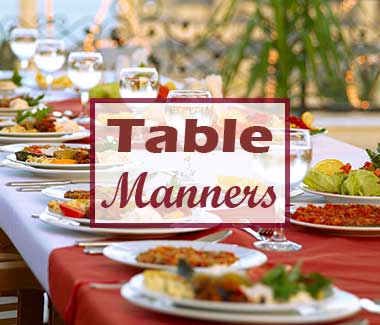Invitation Etiquette
timing
Usethe following general guidelines for timing your invitations:
| Formal Dinner Invitations | 3 to 6 weeks |
| Informal Dinner Invitations | From a few days away to 3 weeks |
| Coctail Party Invitations | 2 to 4 weeks |
| Anniversary Party Invitations | 3 to 6 weeks |
| Thanksgiving Dinner Invitations | 2 weeks to 2 months |
| Christmas Party Invitations | 1 month |
| Bar Mitzvah Invitations | 1 month |
| Graduation Party Invitations | 3 weeks |
| Bon Voyage Party Invitations | Last minute to 3 weeks |
| Housewarming Party Invitations | From a few days to 3 weeks |
| Lunch or Tea Invitations | From a few days to 2 weeks |
invitations by telephone
Start with the relevant details. For example; "Hello, Janey, we are hosting a small get together on Friday night. Can you join us?"
Do not respond to an invitation by saying, ''I'll let you know," unless you follow it with a good explanation. Without an explanation, you are implying that you are waiting for a better invitation to come along. If you do delay in responding, respond as soon as possible (not more than one day).
written invitations
Every guest should receive one.
Very good friends should reply in the same manner as everyone else.
electronic invitations
E-mail invitations can be used for casual events only.
A variety of Web sites offer invitation "cards" that you can personalize, print out, and send in the mail or quickly e-mail.
Sites, such as evite, are also a useful tool.
invitations styles
- casual parties. Preprinted invitations from a stationary store are acceptable for informal dinners or parties.
- extremely casual parties. Invitations can be an informal note or extended by telephone or e-mail (be clear about the date and hour).
- very formal dinners. Invitations may be engraved or written by hand in the third-person style.
pre-printed formal invitations
Formal invitations are usually printed on cards.
- The lettering is a matter of personal preference, but the plainer the design, the clearer the message.
- Punctuation is used only when words requiring separation occur on the same line, and in certain abbreviations, such as "Mr." or "R.S.V.P.”
- black tie. Hosts who want their guests to dress formally should indicate this on their invitations. If the phrase "black tie" is used, it should appear in the lower right-hand corner of the invitations.
handwritten invitations and replies
- When a formal invitation to dinner or luncheon is handwritten instead of engraved, plain white or cream notepaper or paper engraved or printed with the house address or the family's crest is often used.
- The wording and spacing must follow the engraved model's exactly.
- The invitation must be written by hand-it should not be typewritten.
- If the return address on the envelope is not the same as the one to which the replies are to be sent, the address for replies must be written under the R.S.v.P. in the left-hand corner of the invitation.
- Replies are addressed to the person, or persons, who issues the invitation.
- When a response card is sent with the invitation, it should be used for the reply, rather than a handwritten response.
formal dinner invitations
Private dinners formal enough for third-person invitations are uncommon. Diplomatic and official dinners require formal invitations.
invitations to lunch
Invitations to lunch are usually telephoned. For a very formal lunch, an engraved card is used, especially if the lunch is given in honor of someone.
- A formal invitation to lunch is, however, more often in the form of a personal note or on a fill-in invitation.
- It is usually mailed at least two weeks in advance.
- The personal invitation might read:
Dear Janey and Richard,
Please join us for a lunch party at our home on Saturday, July 15, at 12:30 P.M. to meet our new neighbor, Maxwell Lewis. I do hope you will be able to join us.
Best,
Eve



